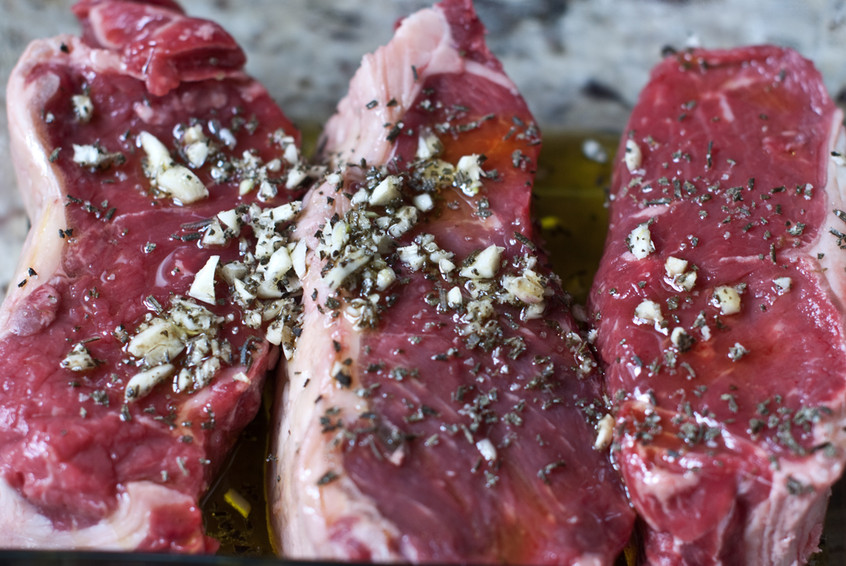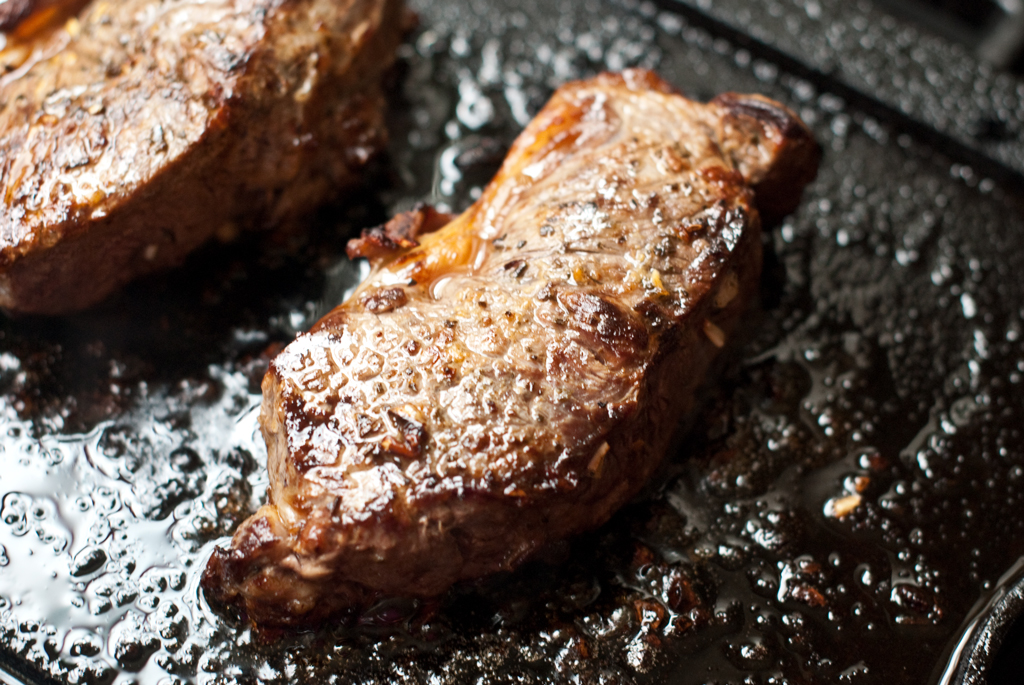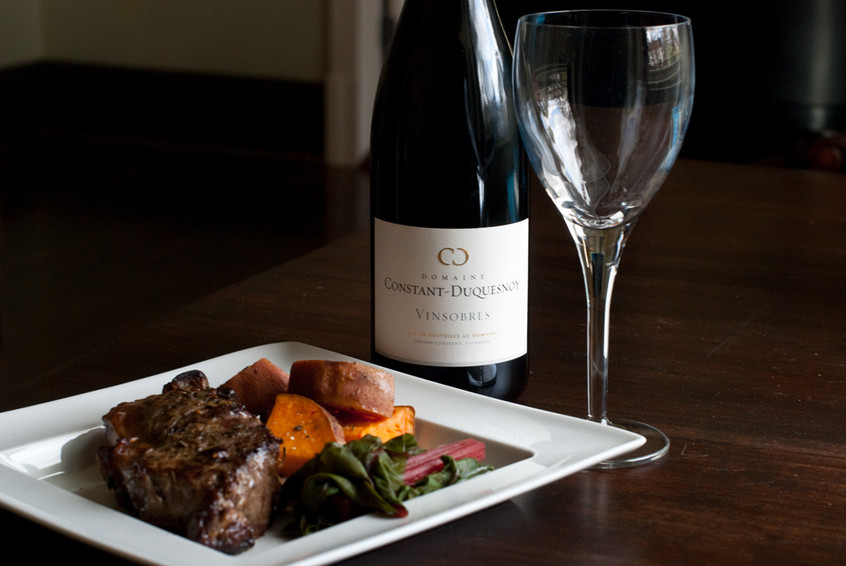A perfectly seasoned and cooked steak will melt in your mouth like butter. Most people grill their steaks but I love to cook mine in a cast iron skillet like most steakhouses. Be prepared for a lot of smoke and the wonderful smell filling your home.
With a high quality steak you can flavor the meat with a simple marinade, sea salt and black pepper. Since I do not like pepper, I add fresh herbs and my preference is rosemary. I also add some garlic for the anti-inflammatory properties and taste.
Did you know you can decrease your exposure to potential carcinogens by marinading your steak or meat with an acid like red wine, vinegar, or lemon juice? I have read it can decrease your exposure to heterocyclic amines (HCAs) and polycyclic aromatic hydrocarbons (PAHs) by 99% since the acid acts as a invisible shield blocking these potential DNA damaging agents from sticking to the meat. So make sure you squeeze a lemon over the meat or pour some red wine on top along with a good oil like refined coconut or olive oil. Italian dressing works well too.
Now there are two philosophies on seasoning. Mark’s Daily Apple discusses the salt early theory and the salt late theory. He also goes over the different cuts of meat for you to decide if it is worth the money to buy the grass fed tenderloin versus the sirloin. At the bottom, I included a summary of the different cuts as well from the Ultimate Cookbook. We do not eat much red meat but when we do I splurge on the tenderloin since it is so tender and not as fatty.
“The Salt Early Theory: Salting meat many hours or even days before cooking breaks down the protein in meat and makes it more tender. Initially, the salt draws out moisture, but over time the meat re-absorbs the moisture, which is now flavored with salt and therefore adds more succulent flavor to the meat.
The Salt Late Theory: Salt dries meat out. Period. Don?t add it until immediately before cooking.
In this debate, we take the middle road. In our experience, the salt early theory rings true with larger or tougher cuts of beef. For your average steak, salting about a half-hour before cooking is ideal and seasoning right before cooking works just fine, too.” Mark’s Daily Apple
Now to cook the meat, you have two options: an easy way and a really easy way. For the easy way, you sear the steak for 2 to 3 minutes on each side in a very hot skillet and then pop the skillet in the oven at 500 degrees until the meat is 5 degrees below your desired temperature. The really easy way is to broil the steak the entire time in the oven on high. You must heat the skillet in the oven so it is very hot before you add the meat. You will know it is hot enough when drops of water dance across the skillet.
Then add a tablespoon of butter and place the steak right on the butter and let it sear the bottom and the broiler sear the top. Use a meat thermometer if you are unsure when your meat is done. Pull the meat out 5 degrees before your desired doneness. It will continue to cook while the meat is resting. This website give a great description on cooking steak and a red wine sauce to pour over the top of the steak.
Here is a quick reference for temperature from a chef’s perspective (you may have been taught rare is 140, medium is 160, well done is 180 degrees):
- Rare-125 degrees, if you press down on the meat it will be squishy
- Medium-rare- 125-130, it will be spongy
- Medium- 130-135 degrees, it will be firm
- Medium-well-135 to 140 degrees
- Well- 140 and above
Now to make this meal as healthy as possible, I highly recommend buying grass fed beef, using fresh rosemary, and serving sweet potatoes. Serving a salad or steamed green on the plate would add a ton of nutrients but so many women tell me their husbands will not touch anything green on the plate. They will not say a word about the rosemary or other herbs you choose to season the meat. Rosemary has immune boosting abilities and anti-inflammatory properties as well as helps with digestion. Use fresh rosemary for superior flavor as well as more manganese and health properties.
Even though creamy, cheesy mashed potatoes are one of the best things on earth, I highly recommend steaming or roasting some sweet potatoes to help stabilize blood sugars as well as all benefits from the vitamins. Sweet potatoes have beta-carotene and vitamin C to remove free radicals in your body that can lead to cancer. The root vegetable also has fiber, manganese, potassium, iron, and vitamin A. Vitamin A can help with emphysema. It is important to buy organic potatoes and eat the skin.
The easiest change to make is buying grass fed, pasture raised beef. The meat contains more CLA to help lower your cholesterol and more Vitamin E which is good for your skin. Grass fed cows are allowed to roam and build more muscles and graze on grass. Cows do not metabolize the genetically modified corn or soy grain as well as grass. Plus, grain fed cows usually have more antibiotics since they are kept indoors in tight quarters where sickness can spread more quickly. I know my kids seem to get sick more often when they cannot go outside to play due to the cold or rain.
Directions
1) Scrub the sweet potatoes and cut them up into 1 inch slices or cubes. Leave the skin on. Steam them for 7 to 10 minutes or roast them. To roast, coat with some olive oil, honey, good sea salt like Sel Gris (French Grey) or Himalayan, and cinnamon. Roast at 375 degrees for about 30 minutes or until soft. Here is a recipe. Make sure you add cinnamon since it helps with digestion and has anti-inflammatory properties as well as so many other benefits.
2) Mince 3 or 4 cloves of garlic in some sea salt or Rosemary French Grey. Create a marinade with equal parts olive oil and an acid like red wine, vinegar, or lemon juice. This is very important for your health as well as flavor. Coat the meat with the oil/acid mixture and sprinkle the garlic and chopped rosemary or Rosemary French Grey salt over all the sides. Marinade for at least 30 minutes. The longer the better.

3) Grill the steaks or broil them. To broil, turn the oven on high broil and place the skillet in the oven. Drop some water on the skillet and if it dances across the pan, it is ready. Add a tablespoon of organic butter to a hot cast iron skillet. Place the steaks on top and broil for 5-7 minutes on each side depending on the desired temperature and thickness of the steak. (Temperature chart provided above.) Take them out of the oven and let them rest for 8-10 minutes. This is important to have a juicy steak.

4) Steam some swiss chard, asparagus or spinach. Serve the steak warm with the greens, roasted potatoes and a good glass of wine. This Vinsobres will go with rosemary steak as well as barbeque pork and lamb coated with rosemary and garlic.

Wine Pairing by Perrine’s Wine Shop
2009 VINSOBRES DOMAINE CONSTANT-DUQUESNOY, RHONE VALLEY, FRANCE
- Vinsobres is a blend of 60% Grenache and 40% Syrah with very low yield 25 hl/Ha
- The wine spends about 10 months in stainless steel vats.
- With a dark ruby color, this wine develops aromas of southern spices, pepper, crushed rocks and “griotte” cherries. Its structure and silky tannins surprises the mouth with a beautiful length.
The Ultimate Cookbook- Choice Steak Cuts
The Cuts of Steak
Flank/London Broil: A popular cut, but can be very fibrous and tough if not properly prepared. It is best to marinate, to tenderize and season. Better not cooked rare or well-done. Slice across the grain.
Sirloin: A larger cut of steak with wonderful flavor because the bone is in. Cooks nicely on the grill, then can be divided into smaller servings or sliced, so it is nice for a family.
T-bone/Porterhouse: A classic cut of steak that is a little like having two steaks in one. There is a bone running down the middle, and on one side you have the strip and on the other the fillet. There is some fat and flavor around the bone, while the steaks themselves are lean. Look for a good l½-inch thickness.
Ribeye: A cut with quite a bit of marbling. It is really the same cut as the prime rib, only It is cut into steak for the grill (instead of roasted and sliced). The marbling gives flavor and tenderness.
Strip/Top Loin: The strip is a lean cut from the top loin that is quite popular. Because it as less marbling, it also can have less flavor. A great choice for those watching fat content. Usually sold an inch thick or more.
Tenderloin/Filet Mignon: Cut from the tenderloin, the filet is the leanest cut of meat. It takes a little longer to cook because it is the thickest cut. Because of the leaness, it can lack flavor, which is why they are often wrapped in bacon. For cooking medium-well or well-done, butterfly the steak first.
References:
https://www.livestrong.com/article/2702-facts-health-benefits-sweet-potatoes/
https://www.whfoods.com/genpage.php?tname=foodspice&dbid=75
https://www.whfoods.com/genpage.php?tname=foodspice&dbid=64
https://www.care2.com/greenliving/10-surprising-health-benefits-of-cinnamon.html
https://bbq.about.com/od/steaks/ss/aa071507a_7.htm
https://www.cnn.com/2010/HEALTH/07/02/how.make.grilling.safe/index.html
https://bbq.about.com/cs/cookingtips/a/aa022401a.htm
